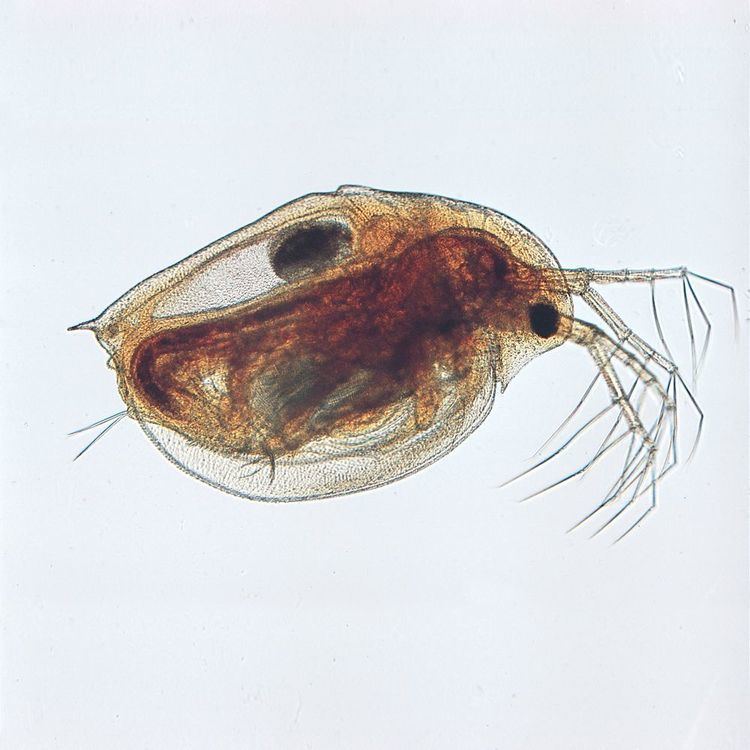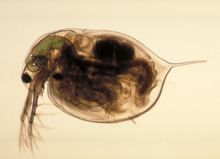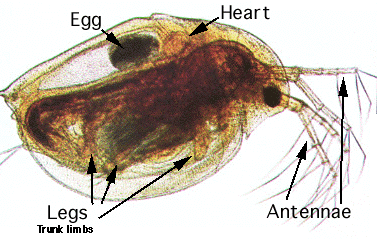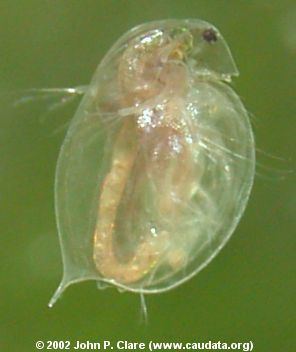Rank Genus | Scientific name Daphnia Order Water flea | |
 | ||
Lower classifications Daphnia magna, Daphnia pulex, Daphnia galeata, Daphnia lumholtzi, Daphnia barbata | ||
Daphnia heartbeat
Daphnia, a genus of small planktonic crustaceans, are 0.2–5 millimetres (0.01–0.20 in) in length. Daphnia are members of the order Cladocera, and are one of the several small aquatic crustaceans commonly called water fleas because their saltatory (Wiktionary) swimming style resembles the movements of fleas. Daphnia live in various aquatic environments ranging from acidic swamps to freshwater lakes, ponds, streams and rivers.
Contents
- Daphnia heartbeat
- Reproduccion de daphnia o nitimita forma casera
- Appearance and characteristics
- Systematics and evolution
- Ecology and behaviour
- Life cycle
- Conservation
- Uses
- Invasive species
- References

The two most readily available species of Daphnia are D. pulex (small and most common) and D. magna (large). They are often associated with a related genus in the order Cladocera: Moina, which is in the Moinidae family instead of Daphniidae and is much smaller than D. pulex (approximately half the maximum length). Daphnia eggs for sale are generally enclosed in ephippia (a thick shell, consisting of two chitinous plates, that encloses and protects the winter eggs of a cladoceran).

Reproduccion de daphnia o nitimita forma casera
Appearance and characteristics

The body of Daphnia is usually 1–5 millimetres (0.04–0.20 in) long, and is divided into segments, although this division is not visible. The head is fused, and is generally bent down towards the body with a visible notch separating the two. In most species, the rest of the body is covered by a carapace, with a ventral gap in which the five or six pairs of legs lie. The most prominent features are the compound eyes, the second antennae, and a pair of abdominal setae. In many species, the carapace is translucent or nearly so and as a result they make excellent subjects for the microscope as one can observe the beating heart.

Even under relatively low-power microscopy, the feeding mechanism can be observed, with immature young moving in the brood pouch; moreover, the eye being moved by the ciliary muscles can be seen, as well as blood cells being pumped around the circulatory system by the simple heart. The heart is at the top of the back, just behind the head, and the average heart rate is approximately 180 bpm under normal conditions. Daphnia, like many animals, are prone to alcohol intoxication, and make excellent subjects for studying the effects of the depressant on the nervous system due to the translucent exoskeleton and the visibly altered heart rate. They are tolerant of being observed live under a cover slip and appear to suffer no harm when returned to open water. This experiment can also be performed using caffeine, nicotine or adrenaline, each producing an increase in the heart rate.
Systematics and evolution

Daphnia is a large genus – comprising over 200 species – belonging to the cladoceran family Daphniidae. It is subdivided into several subgenera (Daphnia, Australodaphnia, Ctenodaphnia), but the division has been controversial and is still in development. Each subgenus has been further divided into a number of species complexes. The understanding of species boundaries has been hindered by phenotypic plasticity, hybridization, intercontinental introductions and poor taxonomic descriptions.
Ecology and behaviour
Daphnia species are normally r-selected, meaning that they invest in early reproduction and so have short lifespans. An individual Daphnia life-span depends on factors such as temperature and the abundance of predators, but can be 13–14 months in some cold, oligotrophic fish-free lakes. In typical conditions, however, the life cycle is much shorter, not usually exceeding 5–6 months.
Daphnia are typically filter feeders, ingesting mainly unicellular algae and various sorts of organic detritus including protists and bacteria Beating of the legs produces a constant current through the carapace which brings such material into the digestive tract. The trapped food particles are formed into a food bolus which then moves down the digestive tract until voided through the anus located on the ventral surface of the terminal appendage. The second and third pair of legs are used in the organisms' filter feeding, ensuring large unabsorbable particles are kept out, while the other sets of legs create the stream of water rushing into the organism.
Swimming is powered mainly by the second set of antennae, which are larger in size than the first set. The action of this second set of antennae is responsible for the jumping motion.
Life cycle
Most Daphnia species have a life cycle based on "cyclical parthenogenesis", alternating between parthenogenetic (asexual) reproduction and sexual reproduction. For most of the growth season, females reproduce asexually. They produce a brood of diploid eggs every time they moult; these broods can contain as few as 1–2 eggs in smaller species, such as D. cucullata, but can be over 100 in larger species, such as D. magna. Under typical conditions, these eggs hatch after a day, and remain in the female's brood pouch for around three days (at 20 °C). They are then released into the water, and pass through a further 4–6 instars over 5–10 days (longer in poor conditions) before reaching an age where they are able to reproduce. The asexually produced offspring are typically female.
Towards the end of the growing season, however, the mode of reproduction changes, and the females produce tough "resting eggs" or "winter eggs". When environmental condition deteriorate (e.g. crowding), some of the asexually produced offspring develop into males. The females start producing haploid sexual eggs, which the males fertilise. In species without males, resting eggs are also produced asexually and are diploid. In either case, the resting eggs are protected by a hardened coat called the ephippium, and are cast off at the female's next moult. The ephippia can withstand periods of extreme cold, drought or lack of food availability, and hatch – when conditions improve – into females (They are close to being classed as extremophiles) .
Conservation
Several Daphnia species are considered threatened. The following are listed as vulnerable by IUCN: Daphnia nivalis, Daphnia coronata, Daphnia occidentalis, and Daphnia jollyi. Some species are halophiles, and can be found in hypersaline lake environments, an example of which is the Makgadikgadi Pan.
Uses
Daphnia spp. are a popular live food in tropical and marine fish keeping. They are often fed to tadpoles or small species of amphibians such as the African dwarf frog (Hymenochirus boettgeri).
Daphnia may be used in certain environments to test the effects of toxins on an ecosystem, which makes them an indicator genus, particularly useful because of its short lifespan and reproductive capabilities. Because they are nearly transparent, their internal organs are easy to study in live specimens (e.g. to study the effect of temperature on the heart rate of these ectothermic organisms).
Because of their thin membrane, which allows drugs to be absorbed, they are used to monitor affects of certain drugs, such as adrenaline or capsaicin, on the heart.
Invasive species
Some species of daphnia or water fleas that resemble daphnia have developed permanent, non-temporary defenses against fish eating them such as spines and long hooks on the body which also cause them to become entangled on fishing lines and cloud water with their high numbers. Species such as Bythotrephes longimanus AKA "spiny water flea" and formerly known as Bythotrephes cederstroemi (native to Northern Europe and Asia), Cercopagis pengoi AKA "fishhook waterflea" (native in the brackish fringes of the Black Sea and the Caspian Sea) and Daphnia lumholtzi (native to east Africa, the Asian subcontinent of India, and east Australia) have these characteristics and great care should be taken to prevent them from spreading further in North American waters.
Some species of daphnia native to North America can develop sharp spines at the end of the body and helmet-like structures on the head when they detect predators, but this is overall temporary for such daphnia species and they do not completely overwhelm or discourage native predators from eating them. While daphnia are an important base of the food chain in freshwater lakes (and vernal pools), they become a nuisance when they are unable to be eaten by native macroscopic predators and there is some concern that the original spineless and hookless water fleas and daphnia end up out-competed by the invasive ones. (This may not be the case, however, and the new invaders may mostly be a tangling and clogging nuisance.)
